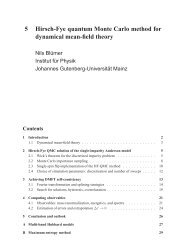Hubbard Model for Asymmetric Ultracold Fermionic ... - KOMET 337
Hubbard Model for Asymmetric Ultracold Fermionic ... - KOMET 337
Hubbard Model for Asymmetric Ultracold Fermionic ... - KOMET 337
Create successful ePaper yourself
Turn your PDF publications into a flip-book with our unique Google optimized e-Paper software.
5.2. GENERAL PROCEDURE 49with an antihermitian operator S:S † = −S . (5.8)Thus we trans<strong>for</strong>m the set of fermionic creation and annihilation operators c into new“dressed”fermionic operators d so that the Hamiltonian can be rewritten as H(d) = H U (d)+H t (d). The aim of this trans<strong>for</strong>mation is that with the new operators the number of doubleoccupancies remains unchanged by the new hopping term H t (d). Double occupancy in the“new language” of the d-operators is a good quantum number. More <strong>for</strong>mally we have:[H U (d), H t (d)] = 0 , (5.9)so that the application of H t to a state of the Fock-space does not influence the number ofdouble occupancies counted by H U . Equation (5.9) determines how S(d) has to be chosen. Inorder to do this we treat the hopping term perturbatively by multiplying it with a bookkeepingparameter λ and per<strong>for</strong>ming an expansion in powers of λ:H t (c) → −λ ∑ ijσt ijσc † iσ c jσ; λ ≥ 0 . (5.10)Putting (5.7) into (5.6) gives us H in terms of d:H = exp[S(d)]{U ∑ i¯n i↑¯n i↓− λ ∑ ijσt ijσd † iσ d jσ}exp[−S(d)] , (5.11)where ¯n iσ= d † iσ d iσis the number operator <strong>for</strong> dressed fermions. Obviously, at λ = 0, theHamiltonian is unperturbed, so that we choose d = c and there<strong>for</strong>e S(d) = 0. With thischoice we get H U (d) = H U (c) = H, so that the trans<strong>for</strong>mation is the identity trans<strong>for</strong>mationat λ = 0. There<strong>for</strong>e we expand S(d) and H t (d) in powers of λ:andS(d) =H t (d) =∞∑S n (d)λ n (5.12)n=1∞∑H t,n (d)λ n (5.13)n=1in order to get H(d) in powers of λ. Generally n th order perturbation theory is per<strong>for</strong>med bydetermining S 1 -S n−1 so that (5.9) is satisfied in the n lowest powers of λ:[H U (d), H t (d)] = O(λ n+1 ) . (5.14)If we also want to express the old operators c correctly in n th order of λ, it is necessary tocalculate S n , too, but, <strong>for</strong> determining the energy, knowledge of S n is unnecessary.5.2.1 Second order perturbation theoryWe will now neglect all terms of O(λ 3 ) and higher in order to satisfy (5.14) <strong>for</strong> n = 2:exp[±S(d)] = 11 ± λS 1 (d) + λ 2 { 1 2 S2 1 (d) ± S 2(d)} + O(λ 3 ) , (5.15)so that H(d) can also be expressed in powers of λ:H(d) = H U (d) + λH t,1 (d) + λ 2 H t,2 (d) + O(λ 3 ) . (5.16)













